Manuscript accepted on :April 11, 2016
Published online on: 26-04-2016
Plagiarism Check: Yes
Zhanar Nurmahanbaevna Kaipova1,Marat Isakovich Satayev1, Rustem Feliksovich Altynbekov1,Radyuk Svetlana Nikolaevna2,Orazova Mereke Mamyrovna3
1M. Auezov South Kazakhstan State University, Kazakhstan, Shymkent. 2Southern Methodist University, USA, Dallas. 3South Kazakhstan State Pharmaceutical Academy,Kazakhstan, Shymkent.
DOI : https://dx.doi.org/10.13005/bpj/901
Abstract
Organic load conditions and parameters on the anaerobic bio reactor operation, where comfort temperature is 35ºC, were determined. A specific biogas output, fallen into1 m3 of the bioreactor and specific biogas output, fallen into 1 kg of remote COD from the bioreactor organic load, were determined. The relationship between the run down time and solids content based on viscosity measurement was determined. The relationship between measured run down time and corresponding solids content in the fermenting material, as well as relationship between content of COD and organic solids in the substrate mixture were found. The relation between change in NH4-N percentage in Ntotal –N, as well as between content of organic solids in the substrate mixture and settling time of the substrate were determined.The content of organic solids in the substrate mixture and СН4output per one ton of the clean substrate and per one ton of the organic solids was correlated.
Keywords
bioreactor; reactor operation; organic solids
Download this article as:| Copy the following to cite this article: Kaipova Z. N, Satayev M. I, Altynbekov R. F, Nikolaevna R. S, Mamyrovna O. M. Study of Biogas Output Increase Depending on Organic Load Conditions and Parameters. Biomed Pharmacol J 2016;9(1) |
| Copy the following to cite this URL: Kaipova Z. N, Satayev M. I, Altynbekov R. F, Nikolaevna R. S, Mamyrovna O. M. Study of Biogas Output Increase Depending on Organic Load Conditions and Parameters. Biomed Pharmacol J 2016;9(1). Available from: http://biomedpharmajournal.org/?p=6824 |
Introduction
Energy is a moving force foreconomic development of many countries of the world. Biochemical processes, such as anaerobic digestion allow produce clean energy in the form of biogas [1]. A biotechnological process for the biogas production was developed in India. The suggested technology allows recover wastes, produce clean electric energy and manure.
Thepaper [2] studied digestion factors: culture time, initial temperature and рН. The end oglucanase (CMCase) activity of MY6 was increased by 200.74% and reached 137.36 U/ml under the optimized conditions (cultured for 48 h at pH7.0 and 40ºC with shaking at 160rmp); while the activity of FY2 was enhanced by150.61% and achieved 177.58 U/ml under the optimized conditions (cultured for 48 hat pH7.0 and 45°C with shaking at 160 rmp).
Three types of biogas plants: continuously-operated, semi-continuous, regularly-operated were studied [3]. A boiler design for the regular operation and effective gas production in various load conditions was developed. Different tests that can help in accessing biogas as a contender for new generation energy source are controlled cooking test, kitchen performance test, boiling test, etc.1.0m3of biogas is equal in energy content to1.7 L of bioethanol, 0.97 m3of natural gas and 1.1 L of gasoline.
Physical and chemical properties of wastes, such as rumen, waste water and manure were studied [4]. The waste water has the potency for producing total biogas as 2.472 m3/m3of waste water. The degradation of cattle manure has the potency for producing total biogas of 618.90 L/kg in dry based by the composition of CH4, CO2, NH3were 48.89, 47.87, and 2.43 % volume, respectively. In other terms, cattle manure will produce CH4as 305.06 L/kg in dry based.
The research results [5] showed that rumen fluid inoculated in the bio-boiler significantly increased the biogas production in more than two times compared to manure. At four F/I tested, after 80 days digestion, the biogas yield were191, 162, 144 and 112 mL/g VS, respectively. About 80% of the biogas production was obtained during the first 40 days of digestion. The best performance of biogas production will be obtained if F/I ratio is in the range of 17.64 to 35.27 (correspond to 25–50% of rumen fluid).
The paper [6] analyzed effect of temperature, time, pH on the organic load of carbon nitrogen. The research showed that two-staged reactor leads to the biogas and methane output enhancement in comparison with one-staged reactor. However, two-staged reactors require more capital expenditures.
The paper [7] studied utilization of wastes for the biogas production, after which a slag has high nitrogen and carbon content. The slag can be used as a fertilizer and additionally treated for the gas production. Coconut husk, agricultural and cellulose wastes can be used as the wastes. The disadvantage of slow reaction times from the biogas (methane) production by bacterialaction is avoided.
It is possible to enhance the biogas production significantly adding chicken feather [8]. In case of biologically delignified bagasse, increase in biog as production is less compared to chemically delignified bagasse. Compared to control, there was considerable increase in biogas production after supplementing chicken feather hydrolysate in both chemical and biologically delignified bagasse. Pretreatment of bagasse results in improved biogas production. Chemical method is faster, effective and cheaper than biological method. Chicken feather hydrolysate as nitrogen/amino acid additives enhances biogas from the delignified bagasse.
The paper [9] carried out analys is for processing of biodegradable wastes (haulm) in the processes of two phase methane production and organic fertilizers. The methane volume, formed from the biomass was higher in comparison with control one. It was shown that yard wastes can be used as a substrate for the methane production.
The studies [10] on the biogas production on a plant, which consists of a mixing chamber, boiler and regulating device were carried out. Results indicated that methane content of the scrubbed/purified biogas was raised from 58% to 82% due to the reduction of Carbon dioxide and Hydrogen Sulfide. CO was reduced from 31% to 14% while HS was reduced from 1% to 0.4%. The corresponding Energy content of the purified biogas was evaluated to be 41 MJ/kg which is higher than that of the raw biogas which was evaluated to be 29 MJ/kg.
The paper[11] considers effect of temperature factors and organic load on biochemical processes of highly concentrated waste waters’ treatment from organic impurities and stabilization of settlings. It was shown that comparative effectiveness of a duck manure anaerobic digestion in a psychrophilic mode, at temperatures of 10 and 20ºC, was 51.4…78.5% and 65.0…86.2%, respectively.In a mesophilic mode at temperatures of 30 and 35ºC, these indicators were 81.8…94.9% and 73…95.9%, respectively, depending on the treatment duration. The specific biogas output per 1 kg of remote COD is fluctuated depending on the organic load of the bioreactor and temperature mode of the anaerobic treatment within the limits from0.117 m3/kg of COD at temperature 10ºC and treatment time 0.67 of a day to 0.520m3/kg of COD at temperature of 35°Сand treatment time 1.5of a day.
The paper [12] established that for the biogas production the best is a mixture of manure and content of cattle rumen (wastes of meat industry), then a sugar-beet pulp. A brewing waste is the most difficult fermented raw material. It was shown that A maranthuscruentus phytomass is a stimulant of methane-genesis-difficult-fermented substrates, such as brewing waste and sugar-beet pulp. Inthepresence of Amaranthus, the methane formation in the biogas may significantly increase. In a case of the manure, there is acceleration of the process.
Authors of the research [13] established effect of the load by the substrate on biotechnological parameters of the methane digestion process. The main reason of acidization effect origin at the digestion of the main substrate and co-substrates was determined. Calcium carbonate and calcium defecation were offered as disoxidating agents. Optimum relationship of the disoxidating agents to the studied co-substrates was obtained. Thus, use of buffer systems on the basis of calcium carbonate is them a in factor, regulating acid-carbonate balance in the digestion systems of acidogenic substrates and determining potential to the load increase with the biogas output increase without loss of its quality. Obtained optimum relationship of the disoxidating agents(in terms of calcium carbonate) to the studied co-substrates appeared equal for calcium carbonate and calcium defecation and consisted 55% of calcium carbonate to the organic solid content of the co-substrate.
The papers [14-16] carried out analysis of present electro technics, where magnetic field effect on the organic substrate allows obtain high effectiveness of the anaerobic digestion process intensification.
Analysis of factors [17], influencing on the digestion process rate and amount of the obtained biogas, proves that there is close interrelation between characteristics of the initial substrate, loading conditions, operating temperature and dwelling time of the substrate in the methane tank. Currently it is impossible analytically determine exact effect of each separate factor on the formed biogas amount.
Forobjectiveestimationoftheinitialrawmaterialqualityandexternalfactorseffectonthedigestionrateinthemethane tank and biogas output volume, it is reasonable to carry out experimental studies on laboratory and industrial plants.
The paper [18] introduces research results of the chicken manure anaerobic methanogenic digestion, where optimal values of the specific output on the mixing, equal to 3 W/m-3and hydraulic dwelling time of the substrate, equal to 5 days were determined. Obtained in the laboratory conditions numerical values of similarity tests were used at the bioreactor’s process design for industrial biotechnology of the manure processing by capacity 175 tons a day.
Material and Methods
Classical and modern physical-chemical research methods allowing obtain total characteristic of the research objects were used in the paper. With a view to ensure the obtained biogas safety and quality, certainty of all material and energy resources, conformity of developments by the technology, reliability of measurements in the research and papers, modern measuring equipment, metrological standards, statistical analysis methods of the measurement results providing integration and required precision of measurements, identification of reasonable errors and variations of the results and limits, outside of which they should not fall at the specified probabilities, were used in the research work. The units of measurement correspond to SI metrological rules and norms.
For experimental check and demonstration of renewable energy sources, as well as for the cattle manure anaerobic digestion modes’ development in the laboratory conditions, a laboratory biogas plant with reactor volume 0.25 m3 was designed and prepared in M. Auezov South Kazakhstan State University. According to the scheme, foreign impurities, such as wood chips, straw, stones, residues of rough long stalky feeds, etc., are preliminary removed from the manure. The liquid manure free of these impurities is supplied to the bioreactor for the anaerobic digestion. Amicroflora, which subsequently breaks organic substances to volatile fatty acids, the last under the action of syntrophic and methanogenic bacteria turn into gaseous products – methane and carbon dioxide, is developed in the manure during the digestion. At the same time, the manure’s deodorization, dehelminthization, destruction of weed seeds’ abilities to germinate, conversion of fertilizing element to the mineral form are provided during its digestion. The biogas plant consists of three base apparatus – the bioreactor for the manure’s anaerobic digestion, gas holder, unit for preparation of the manure to the digestion, and auxiliaries for support of the bioreactor system operations. The bioreactor is a cylindrical vessel – the methane tank of black steel by 7 mm thickness. Its depth is 1.5 m, diameter – 530 mm. The reactor is equipped by electric heating unit with heat-exchange surface area in 0.33 m2. The substrate is mixed in the reactor hydraulically with the help of a pump and pipeline system with rectifiers. At the pump’s operation in the mixing mode, the substrate is taken off the reactor and supplied through the pipeline system to its upper part. The digested manure is removed as a fresh portion comes in through the pipeline system for the effluent removal. There is a discharge valve in the reactor’s bottom for its discharge. Table 1 presents main engineering performance of the biogas plant.
Table 1: Main Engineering Performance of the Biogas Plant
| Figures | Unit of measure | Value |
| Total volume of the bioreactor | m3 | 0.25 |
| Gas space volume | m3 | 0.07 |
| Treatmenttemperature
atthemesophilicmode – M at the thermophilic – T |
ºС |
35-37 55-57 |
| Treatment time | 24 hours | 20-22 at M
12-15 at T |
| Pump power for the manure mixing | kW | 0.37 |
| Installed power of the electric heating unit | kW | 2.0 |
| Heat-exchange surface area | m2 | 0.33 |
| Capacity:
by the initial manure М-Т by the biogas М-Т |
l/day l/day |
10-15 100-170 |
| Net weight | kg | 450 |
General requirements to the biogas plants, anaerobic conditions in the methane tank, accuracy in the temperature conditions, acid-base balance, requirements to the process waste characteristics, operating mode of the bioreactor, requirements to the design, water- and gas impermeability, the methane tank design stability, measuring equipment, requirements to the biogas gathering facilities were determined by standards [19-23]: GOST R 52808-2007 Unconventional technologies. Bio-waste senergetics.Terms and definitions, GOST R 53790-2010 Unconventional technologies. Bio-wastes energetics. General operating requirements to biogas plants, GOST 14920-79 DRY GAS Method for determination of compositional analysis, Process procedure. Production of biogas from domestic solid garbage dumps. Scientific and technical information officeAKH. Moscow 1990, GOST 22387.2-97Methods for determination of hydrogen sulfide and mercaptan Sulphur.
Results and Discussion
Experiments for investigation of the organic load effect on the process were carried out. The investigations on the anaerobic bioreactors’ operating modes showed (Figure 1) that at the cattle manure digestion in the mesophilic mode at temperature 35οС, there is a sharp change in the processing effectiveness, i.e. its rapid increase in the beginning of the treatment from 12 to 24 hours from 89 to 95.5%, after some period from 24 to 32 hours consists 95.5 – 96%, achieves final stationary value and does not rise further.
 |
Figure 1: Dependence of the anaerobic treatment effectiveness on the processing time |
Results of our studies of the biogas specific output fallen into 1 m3 of the bioreactor (Figure 2) shows that at the organic load 25kg COD/m3·day, it achieves adequate specific output of the biogas equal to 14 m3/m3·day. Beginning from 5 kg COD/m3·day of the organic load the biogas specific output rises linearly and proportionally from3 to 14 m3/m3·day, this evidences that the anaerobic treatment is more profitable and effective at the mesophilic processing mode at temperature 35°С.
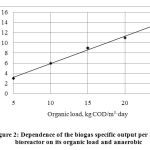 |
Figure 2: Dependence of the biogas specific output per 1 m3 of the bioreactor on its organic load and anaerobic |
The biogas specific output per 1 kg of the remote COD fluctuates depending on the bioreactor organic load at the anaerobic treatment mode. Figure 3 shows that with increase in the organic load from 7 to 16 kg COD/m3·day, there is insignificant reduction of the biogas specific output from 0.53 to 0.5 m3/kg of COD removal. At values from 10 to 13 of the bioreactor organic load, values of the biogas specific output reduce from 0.518 to 0.513.
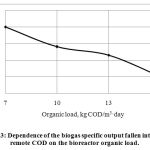 |
Figure 3: Dependence of the biogas specific output fallen into 1 kg of the remote COD on the bioreactor organic load. |
A large volume of the manure in the reactor results in the viscosity increase. Heavy power consumption for the mixing is required for high performance mixing. Optimal relation between content of dry substances and viscosity is determined by the run down time to the full discharge of the reservoir. Pursuant to Figure 4, at the content of dry substance in the reactor equal to 12%, the run down time is 12 days, at the content of dry substance equal to 5%, the rundown time is 4 days. This means proportional increase in the dry substance content on the rundown time.
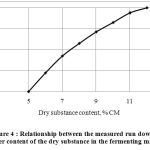 |
Figure 4 : Relationship between the measured run down time and proper content of the dry substance in the fermenting material |
Biological decomposition of the substrate mixture part also characterizes the chemical oxygen demand (COD).As is clear from Figure 5, COD content in the substrate increase from 150 to 400 kg/tСМwith increase in the organic solid content in the substrate from 12 to 32 %. The balanced condition is attained almost completely in the following.
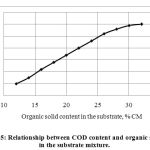 |
Figure 5: Relationship between COD content and organic solid content in the substrate mixture. |
Increase in the gas concentration results in the general nitrogen content increase (Ngen.-N). Mineralization of the organic nitrogen compounds at the anaerobic decomposition results in increase of NH4-N content. Experimental data (Figure 6) of the settling time effect on the change of NH4-Npart in Ngen.-N (absolute %) showed that with increase in the settling time it rises to 68% on the 250th day.
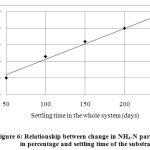 |
Figure 6: Relationship between change in NH4-N part in Ngen.-N in percentage and settling time of the substrate |
The important characteristic of there actor performance is hydraulic settling time value. The load value by the organic solid content effects on the gas formation process. Increase in the settling time in the whole system from 50 to 175 (d) at the organic solid content values in the substrate mixture from 10 to 30% СМ, with increase in the linear dependence,is characteristic for the studied biogas plant (Figure 7).
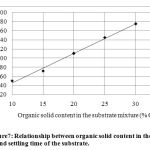 |
Figure 7: Relationship between organic solid content in the substrate mixture and settling time of the substrate. |
It is seen from Figure 8 that increase in the organic solid content in the substrate mixture is accompanied by increase in СН4 output per one tone of the fresh substrate. At the organic solid content equal to 30% we registered maximum output of СН4 140 (nm3/Тsubstrate).
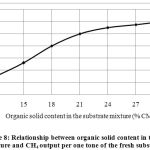 |
Figure 8: Relationship between organic solid content in the substrate mixture and СН4 output per one tone of the fresh substrate. |
Analysis of the obtained dependencies and experimental values between organic solid content in the substrate mixture and СН4output per one of the organic solid content allowed us determine performance criteria of the substrate use. Figure 9 shows obvious increase dynamics in the dependence on the organic solid content in the substrate mixture on СН4output. There is increase in the organic solid content values from 12 to 30 % to СН4output from 220 to 470 nm3/Тorganic solid content.
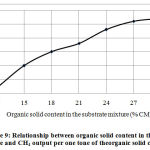 |
Figure 9: Relationship between organic solid content in the substrate mixture and СН4 output per one tone of theorganic solid content |
Conclusion
Experimental results show possibility to reduce the manure treatment process to 1-1.5 days.
Content of dry substances over 12% results in significant increase of the mass viscosity and therefore greatly effects on the fermenter ability to the mixing. This, in turn, should be considered in selection of dimensions of plants for mixing of the substrate in design of the biogas plants.
Content of COD is a good alternative for the organic solid content factor, as in this case there is no any errors in a result of volatile organic acids’ spread.
In connection with various intensity in mineralization of the organic nitrogen compounds, NH4-N content limits significantly extend.
Using raw material with the organic solid content over 30%, general settling time in the plant is optimal.
In the organic solid content from 24 to 30% CM, CH4 output value on the plant achieves its maximum output.
Acknowlegements
We would like to express our gratitude for your support.
The article describes results of research project “Production of fuel gas in the membrane purification of biogas as a raw material for alternative energy”, financed by the Ministry of Science and Education of the Republic of Kazakhstan (Contract No. 278 from 04.02.2014).
References
- Javed Ahmad,Touseef A. Ansari. Biogas from Slaughterhouse Waste: Towards an Energy Self-Sufficient Industry with Economical Analysis in IndiaJ Microbial BiochemTechnol 2012, S12 DOI http://dx.doi.org/10.4172/1948-5948
- ZhouHong-li,YangXiao, XiongDong-mei,Zeng Lu, TianKai-zhong, XiongXing-yao, LiuYun, SuXiao-jun. Isolation, Identification and Characterization of Cellulose- Degradation Bacteriafrom Fresh Cow Dung and Fermentation Biogas Slurry. Research&Reviews:Journal of Microbiology and Biotechnology. RRJMB | Volume 4, Issue 3, July-September, 2015, Р.30-38.
- Jyothilakshmi R. Biogas Technology in Current Indian Scenario as Applicable to its Production, Maintenance and Utilization of the Slurry as Organic Manure after its Enrichment. Research & Reviews: Journal of Engineering and Technology RRJET, Volume 4, Issue 3, July-September, 2015, Р.40-43.
- Budiyono, Widiasa I. N., JohariS.,Sunarso. Study on Slaughterhouse Wastes Potency and Characteristic for Biogas Production. Internat. J. of Waste Resources, Sept. 2011, Vol. 1(2):4-7.
- Sunarso, JohariS., WidiasaI. N., Budiyono. The Effect of Feed to Inoculums Ratio on Biogas Production Rate from Cattle Manure Using Rumen Fluid as Inoculums. Internat. J. of Waste Resources, March 2012, Vol. 2(1):1-4.
- Oliveira F., Doelle K., Anaerobic Digestion of Food Waste to Produce Biogas: A Comparison of Bioreactors to Increase Methane Content–A. Review. J Food Process Technol 2015, 6:8DOIhttp://dx.doi.org/10.4172/2157-7110.1000478
- Rahul Basu, Processing urban waste for energy for reduced greenhouse gases. J BiotechnolBiomater 2015, 5:6DOIhttp://dx.doi.org/10.4172/2155-952X.C1.043
- GopinathanChengalath, Co-digestion with poultry feathers enhances biogas production from bagasse. J BiotechnolBiomater 2015, 5:6 DOI http://dx.doi.org/10.4172/2155-952X.C1.044
- Poulomi Mukherjee, DarshanaSalaskar, Sukhendu B. Ghosh, Sharad P. Kale Studies on feasibility of processing dry leaves by Nisargruna biogas technology. J BiotechnolBiomater 2015, 5:6 DOI http://dx.doi.org/10.4172/2155-952X.C1.043
- Temilola T.Olugasa,Oluwafemi A. Oyesile. Design and Construction of a Water Scrubber for the Upgrading of Biogas. J Fundam Renewable Energy Appl 2015, 5:5 DOIhttp://dx.doi.org/10.4172/2090-4541.1000190
- Kovalev V.V., Unguryanu D.V., Kovaleva O.V. Teoreticheskiye i prakticheskiye aspekty sovershenstvovaniya protsessov biogazovoy tekhnologii. PROBLEMELEL ENERGETICII REGIONALE 1(18) 2012, P.102-114.
- Mindubayev A. Z., Minzanova S. T., Skvortsov YU. V., Mironov V. F., Zobov V. V., Akhmadullina F. YU., Mironova L. G., Belostotskiy D. Ye., Konovalov A. I. Stimuliruyushcheye vliyaniye sukhoy fitomassy amaranta Amaranthus cruentus na biometanogenez v trudnofermentiruyemykh substratakh. Vestnik Kazanskogo tekhnologicheskogo universiteta. Tekhnologiya i apparaty pishchevykh proizvodstv. 2009. No 4. P. 220-226.
- Sotnikov V. A., Sotnikov D. V., Gamayurova V. S., Marchenko V. V. Kal’tsiy – karbonatnaya bufernaya sistema – faktor povysheniya effektivnosti substratnogo i kosubstratnogo metanovogo brozheniya. Vestnik Kazanskogo tekhnologicheskogo universiteta. 2009. No 4.P.198-203
- Obolenskiy N. V., Kraynov YU. Ye. Uvelicheniye vykhoda biogaza s pomoshch’yu gidrodinamicheskikh kavitatsionnykh reaktorov. Vestnik NGIEI Vypusk № 2 / 2012 P.99-104.
- Makarova G.V., Mozharov A.A. Elektrotekhnologii intensifikatsii protsessa anaerobnogo sbrazhivaniya otkhodov zhivotnovodstva. 8-ya Mezhdunarodnaya nauchno-tekhnicheskaya konferentsiya ENERGOOBESPECHENIYe I ENERGOSBEREZHENIYe V SEL’SKOM KHOZYAYSTVE Moskva, 16-17 maya 2012 g.P.189-195.
- Satayev M., Shakirov B., Mutaliyeva B., Satayeva L., Altynbekov R., Baiysbay O. & Alibekov R. Mathematical modeling of methoxyanabasine С11Н16N2O polymer solution ultrafiltration. Heat Mass Transfer. 2012. 48(6), 979-987. http://dx.doi.org/10.1007/s00231-011-0948-8
- Sednin V. A., Sosnin A. V., Prokopenya I. N., Shimukovich A. A. Analiz faktorov, vliyayushchikh na proizvodstvo biogaza pri sbrazhivanii osadka stochnykh vod. Teploenergetika. Izvestiya vysshikh uchebnykh zavedeniy i energeticheskikh ob”yedineniy SNG – Energetika : nauchno-tekhnicheskiy i proizvodstvennyy zhurnal. – 2009. – N 5.P.49-58.
- Khabibullin R. E., Sharifullin V. N. Issledovaniye protsessa anerobnogo sbrazhivaniya kurinogo pometa i inzhenernaya metodika tekhnologicheskogo rascheta bioreaktora. Vestnik KGTU №9, 2010. P.639-646.
- GOST R 52808-2007 Netraditsionnyye tekhnologii. Energetika biootkhodov. Terminy i opredeleniya.
- GOST R 53790-20101 Netraditsionnyye tekhnologii. Energetika biootkhodov. Obshchiye tekhnicheskiye trebovaniya k biogazovym ustanovkam.
- GOST 14920-79 GAZ SUKHOY Metod opredeleniya komponentnogo sostava
- Tekhnologicheskiy reglament. Polucheniye biogaza s poligonov tverdykh bytovykh otkhodov. Otdel nauchno-tekhnicheskiy informatsii AKKH. Moskva 1990.
- GOST 22387.2-97 Metody opredeleniya serovodoroda i merkaptanovoy sery.
(Visited 698 times, 1 visits today)







